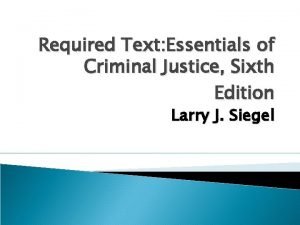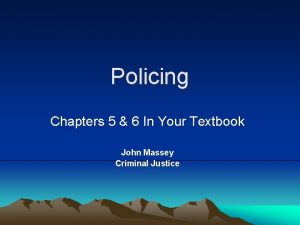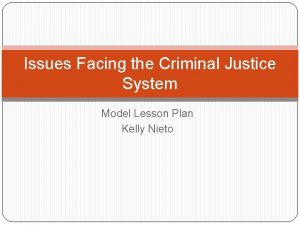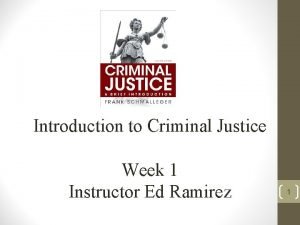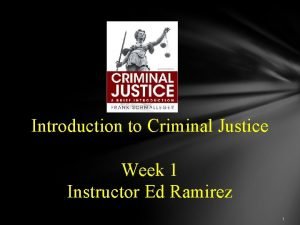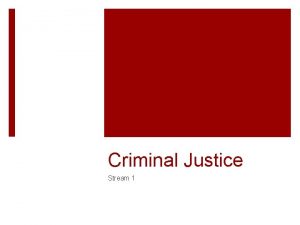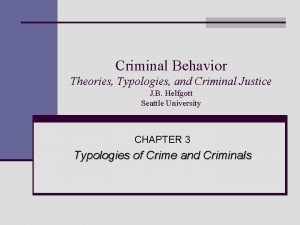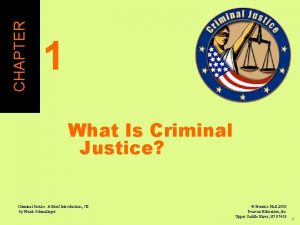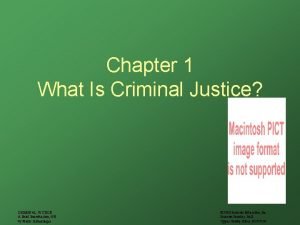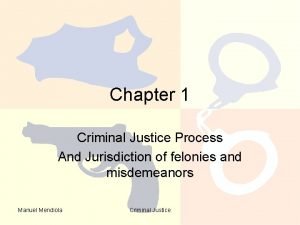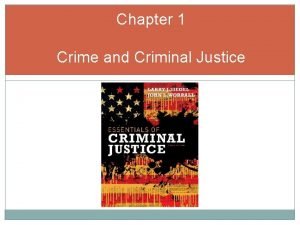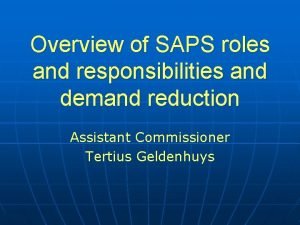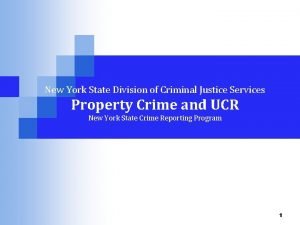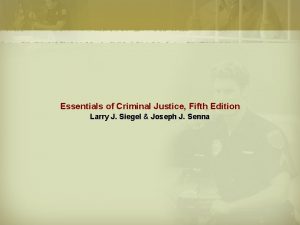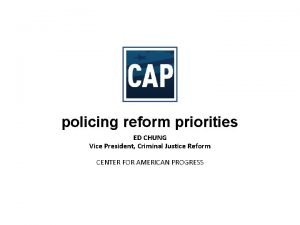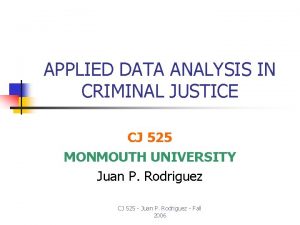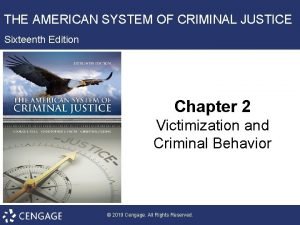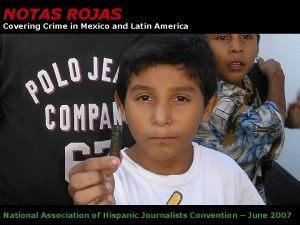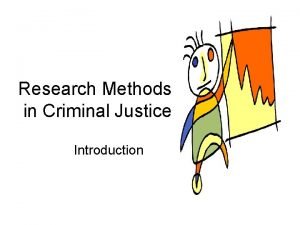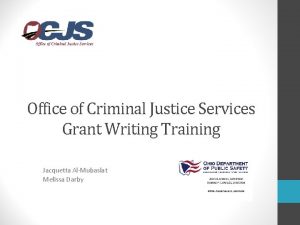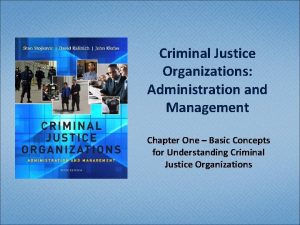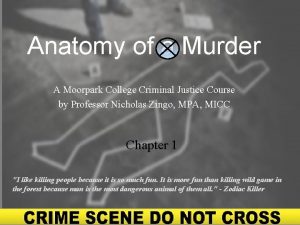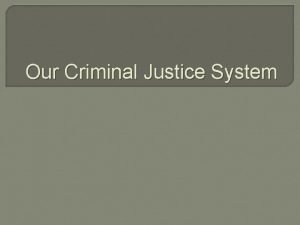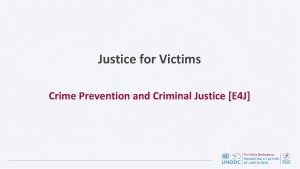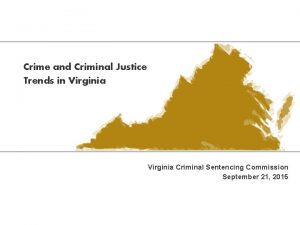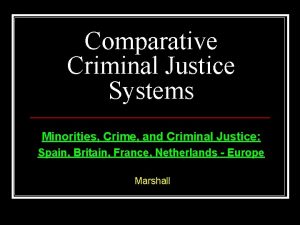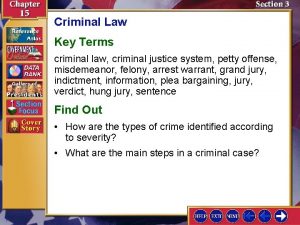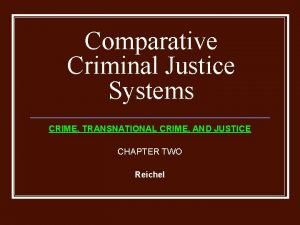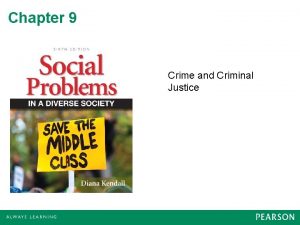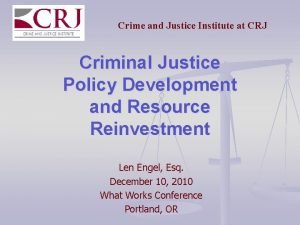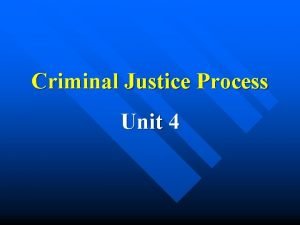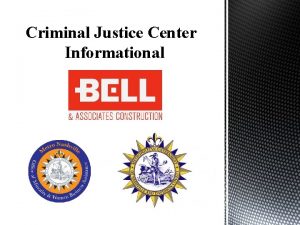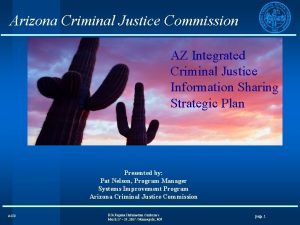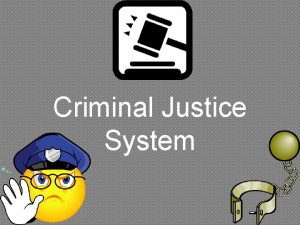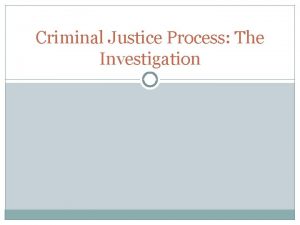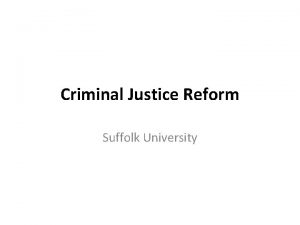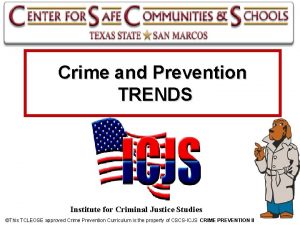E 4 J Crime Prevention and Criminal Justice





































- Slides: 37

E 4 J Crime Prevention and Criminal Justice Series Module 5 – Police Accountability, Integrity and Oversight

MODULE OUTLINE • Definition of essential concepts • Part I - Policing in Democracies and the need for accountability, integrity, oversight o Conceptual origins and the evolution of the role of the police in democratic societies o Key police powers and implications for human rights o Need for police accountability, integrity, oversight • Part II - Actors and mechanisms in police oversight o Internal and executive control o Parliamentary and judicial oversight o Independent complaint bodies o NGOs, the Media, International monitors • Part III- Cross-cutting/ contemporary issues: Gender, Detention, Whistleblowing, Diversity

Part I: Policing in Democracies and the need for accountability, integrity, oversight Conceptual origins and the evolution of the role of the Police • The ‘Social Contract’ theory • Historical evolution of policing ( Ex: Europe – British vs. Continental European) • Peel Principles – foundation of modern policing th • Professionalization of policing – 20 Century • International standards (ICCPR, CERD) state obligations to respect, protect, fulfill human rights • 1979 UN Code of Conduct for Law Enforcement Officials (Co. C) (Arts 1, 2, ): ‘serving the community, protect human dignity, …’uphold human rights’

Part I – Policing in Democracies and the need for accountability, integrity, oversight • Emergence of Human rights based policing: Key principles: participation, accountability, non-discrimination and attention to vulnerability, linkages to human rights standards, access to public officials and equality and gender sensitivity • Ø Ø ‘Democratic Policing’ (Bayley, 2001) Priority: serve the needs of the community Be accountable to the law Protect human rights Be transparent in activities Shift from the ‘warrior mindset’ to ‘protector mindset’ In policing

Part I – Policing in Democracies and the need for accountability, integrity, oversight • Ø Ø Modern definition of the role of the police (Co. E, 2001; OSCE, 2009 ): maintaining public tranquility and law and order; protecting and respecting the individual’s fundamental rights and freedoms; preventing and combating crime; and providing assistance and services to the public Key debates: Despite comprehensive international human rights standards on policing, widespread police violence, abuse, HR violations around the world. Effectiveness of int’l standards? (Posner, 2014) Human rights-based policing make the police weaker in crime fighting?

Part I – Policing in Democracies and the need for accountability, integrity, oversight Coercive Police Powers Fundamental Human Rights Implications Standards for the Exercise of when powers are abused Police Powers Use of Force Stop and Search and seize belongings Arrest Detention Surveillance Investigation Legality Necessity Proportionality Accountability Non-discrimination Violation of - The right to life (death) - Right to liberty and security (arbitrary detention) - Freedom from torture and illtreatment - Right to non-discrimination (racial profiling) - Right to privacy (unlawful surveillance)

Part I – Policing in Democracies and the need for accountability, integrity, oversight Need for Accountability, Integrity, Oversight • Traditional approach to accountability: ‘few bad apples theory’ (Newburn, 2015): reactive, focus on isolated, individual cases. • BUT: Behind any police action: laws, policies, recruitment, training, integrity standards supervisor orders • Need for a more holistic understanding of accountability: ‘before, during, after the act’(UNODC, 2011)

Part I – Policing in Democracies and the need for accountability, integrity, oversight Who holds the police accountable? ‘Without external oversight, police are essentially left to police themselves…purely internal investigation avenues make it all too easy for the police to cover up wrongdoing’ (Philip Alston, A/HRC/14/24/Add. 8) Ø Ø Ø Internal and executive control mechanisms Judiciary Parliamentary oversight committees Independent Police Complaint Bodies NGOs, Media International Monitors Conducting Ex- ante Ongoing Ex-post control and oversight of the police

Part 2 - Actors and Mechanisms in Police Oversight • 2. 1 - Police Internal Control Mechanisms Ø Ex-ante control: Setting professional and integrity standards : Examples: Co. E Code of Police Ethics, Seoul Declaration - INTERPOL, Harare Resolution – SARPCCO Ø Ongoing control : Supervision and monitoring: Continuous supervision by managers, internal audits, inspections and spot-checks by supervisors Ø Ex-post control: Internal Complaints handling mechanisms Should receive complaints both by officers who are subjected to wrongdoing, and members of the general public

Part 2 - Actors and Mechanisms in Police Oversight Ø Key features of an effective complaint mechanism Various ways for lodging a complaint (in-person, online, phone, anonymous) Rights of victims and complainants throughout the investigations are respected and protected (UN Declaration on Victims) Actively inform the public, witnesses, victims, offenders Rights of the accused officer safeguarded (right to be on how to make a complaint notified on the investigation, right to legal aid, right to be heard and defence) Obligation to accept and record the complaint Appeal venues for both the complainant and the accused officer, once the investigation is complete and the sanction is decided upon (if applicable) Standardised procedures for launching, investigating, Data on complaints received, investigated, completing disciplinary proceedings and the sanctions as well as the outcomes are disclosed Internal investigation carried out by a department/ officer, reasonably independent of the accused officer/ unit Complaints data systematically reviewed analysed (with external experts) to identify systemic issues

Part 2 - Actors and Mechanisms in Police Oversight 2. 2. Executive control – Mo. I, Mo. J, inspectorates • Ex-ante: Establish overall vision, overarching policies for police recruitment, performance indicators, promotions and training; develop the disciplinary code (in some jurisdictions, in liaison with the Police) • Ongoing: Ministerial inspectorates assessing police compliance with the law, policy and codes of conduct. Mostly focus on systemic issues, not individual complaints (unless high level or serious, in some jurisdictions) • Ex-post control: Inspection outcomes change strategies, policies to enhance accountability. Dismiss the chief of police (in some jurisdictions) Challenge: The executive, task –masters of the law enforcement, holding the police to account. inspectorates sufficiently independent? Can they be trusted?

Part 2 - Actors and Mechanisms in Police Oversight 2. 3 Judicial Oversight of the Police • Ex-ante autorisation of police powers: Judges review the legality, necessity, proportionality of requests for search warrants, surveillance warrants • Ongoing supervision: Prosecutors conduct, direct, supervise criminal invesigations – scrutinise lawfulness of police activities (in some jurisdictions) • Ex-post oversight through adjudication: Judicial institutions prosecute, try and sentence police officers who committed criminal offences, and provide remedial routes to victims. Challenges: Judicial independence, close cooperation of prosecutors with the police, expertise in complex surveillance related issues, rubber-stamped warrant requests?

Part 2 - Actors and Mechanisms in Police Oversight 2. 4. Parliamentary Oversight of the Police • Ex-ante oversight: Draft, enact laws on policing; review, amend, approve police budget; oversee or approve appointments of police chiefs • On-going oversight: Permanent parliamentary committees summon police chiefs, hold hearings, review reports, launch parliamentary investigations, carry out inspections • Ex-post oversight: Ad-hoc parliamentary inquiry commissions Challenges: MPs’ lack of time, resources, expertise to dedicate to police oversight. Risk of politicisation of police oversight ?

Part 2 - Actors and Mechanisms in Police Oversight 2. 5. Oversight by independent bodies • Police policing themselves, lack of independent investigations of police offences/ misconduct erosion of public confidence in the police (UNHRC, 2010) • International standards emphasis on independent, impartial investigations (BPUFF, art 22) • ECt. HR 5 principles for investigating complaints against the police: independent and prompt investigations, collecting adequate evidence; allowing for public scrutiny and victim involvement in the investigative process • Establishment of Independent Police Complaint Bodies (IPCB)

Part 2 - Actors and Mechanisms in Police Oversight Key features of effective IPCBs • Independence: Institutional, hierarchical, operational independence from the police • Clear mandate: investigate most serious offences v. s all offences +misconduct • Powers: law-enforcement powers to independently investigate offences • Resources: financial, technical, human resources • Accessibility +transparency: receive complaints directly by the public, outreach to most vulnerable, transparency towards complainants and to the general public

Part 2 - Actors and Mechanisms in Police Oversight How do IPCBs handle complaints? IPCB receives complaint by the victim directly or through police referral Publish the investigation report, recommendations, police response; inform the public IPCB conducts independent investigation into the complaint Write a report with recommendations to the police and other institutions for future prevention Disciplinary complaints: Forward the outcome to the police, recommend sanctions Criminal offences: Forward the investigation outcome to the prosecutor Follow- up disciplinary sanctioning / criminal prosecution process Serve as an appeal body (for disciplinary)

Part 2 - Actors and Mechanisms in Police Oversight Other forms of independent oversight of the police • IPCBs also conduct thematic, regular reviews of police use of force, arrest& detention, stop&search, profiling, treatment to groups at risk of vulnerability • Independent oversight also exercised by Ombuds Institutions, National Human Rights Institutions, National Audit Institutions, Anti- Corruption Commissions Challenges: Lack of clear mandate & real investigative powers toothless body erosion of public trust in independent complaints bodies Resistance by law enforcement to cooperate and implement recommendations

Part 2 - Actors and Mechanisms in Police Oversight 2. 6. Oversight by the Civil Society • Ex-ante oversight: Expert contribution to parliamentary + ministerial bodies at law drafting/ reviewing stages • Ongoing oversight: Monitor police activity, collect data, research, publish reports, awareness raising campaigns informed public debate on policing • Ex-post oversight : Launching critical litigation challenging problematic laws or practices of police services (ex: Liberty UK – Investigatory Powers Act) Challenges: Gov’t /Police lack of willingness to cooperate, share information, take on board NGO recommendations

Part 2 - Actors and Mechanisms in Police Oversight 2. 7 Oversight by the Media • Access & publish government and police records on law enforcement policies, activities, statistics foster transparency • Cover parliamentary and court hearings involving police officers • Cooperate with and give voice to activities and campaigns of NGOs and other oversight actors • Carry out investigative journalism to uncover police offences, misconduct, corruption (Friedrich, Masson, Mc. Andrew, 2012) Key debates: The rise of social media, the use of CCTV/other video footage in reporting bring police misconduct/crime to national discourse. Ethical considerations? Other legal restrictions to media oversight?

Part 2 - Actors and Mechanisms in Police Oversight Ethical Considerations for reporting on police incidents Challenges with covering police incidents Risk of violating presumption of innocence Laws restricting access to information /Tendencies for over-classification of information Respecting and protecting the privacy of victims Laws restricting criminalising journalistic activity and their relatives Risk of jeopardising on-going operations /investigations of the law enforcement Laws and practices compelling journalists to reveal their sources Lack of specific safeguards for journalists from intrusive surveillance

Part 2 - Actors and Mechanisms in Police Oversight 2. 8. Monitoring and Oversight by International Actors • Adjudication by regional courts and tribunals • UN Treaty Bodies, Special Rapporteurs • International NGOs

Part 3: Cross-cutting and contemporary issues in police accountability 3. 1. Police accountability and Gender Accountability for police responses to SGBV cases: need closer attention because • SGBV victims less likely to report – fear of revenge, social stigmatisation • Additional challenges/risks during reporting and investiogation stages (UNODC, 2010) o Police officers not taking reports seriously, not recording crimes properly o Officers’ treatment of victims secondary victimisation o Insufficient measures to protect the safety of victims ECt. HR ruling on the Kontrova v. Slovakia

Part 3: Cross-cutting and contemporary issues in police accountability 3. 1 Police accountability and Gender A holistic approach to overseeing police response to SGBV: • National legal framework: Compliance with CEDAW, Declaration on the Elimination of Va. W, Beijing Declaration and Pf. A • Comprehensive strategy: Compliance with Updated Model Strategies and Practical Measures on the Elimination of Va. W in Crime Prevention and Criminal Justice • Police institutional/operational policies: specialised unit + detailed SOP for investigating SGBV, gender-balanced team, cooperation mechanisms with other agencies, gender-sensitive data collection, internal review of police response • Training on gender +SGBV: root causes, manifestations and different forms of SGBV, identify potential subconscious bias against women , esp vulnerable women

Part 3: Cross-cutting and contemporary issues in police accountability Police officers as perpetrators of SGBV International Association of Police Chief’s ‘Model Policy on Domestic Violence by Police Officers’: • Strongly prohibit any form of SGBV in ethical codes • New recruits comprehensive vetting to check history of SGBV • Random checks of computer/social media use Early warning signs (Bastick, 2014) • Develop internal policy to combat sexual harrasment and other forms of SGBV • Reach out to partners and families of police officers, inform them on policies • Domestic violance complaints against police officers seize weapons+protect victims • Proceedings establish SGBV offence terminate employment • Gender responsive complaints mechanisms (Bastick, 2014)

Part 3: Cross-cutting and contemporary issues in police accountability 3. 2. Police detention and accountability International standards on police detention and accountability: • ICCPR, CAT, CPED • United Nations Standard Minimum Rules for the Treatment of Prisoners (the Mandela Rules), • Body of Principles for the Protection of All Persons under Any Form of Detention or Imprisonment, • United Nations Rules for the Treatment of Women Prisoners and Non-custodial Measures for Women Offenders (The Bangkok Rules), • United Nations Rules for the Protection of Juveniles Deprived of their Liberty (Havana Rules).

Part 3: Cross-cutting and contemporary issues in police accountability Mandela Rules – Section C: Specific rules for police custody Respect presumption of innocence Separate from convicted prisoners Offer the opportunity to work, but not oblige detainees to work Inform the detainee on reasons for police custody and charges against them Assign a legal adviser, if the detainee does not have one Provide the detainee with material for preparation of defence If so desired, allow the detainee to, at his/her own expense: • have their food procured the outside ; • Procure such books, newspapers, writing material and other means of occupation • to be visited and treated by his or her own doctor or dentist • wear his or her own clothing if it is clean and suitable. • (otherwise the standards for provision of aforementioned services apply to them)

Part 3: Cross-cutting and contemporary issues in police accountability Ex-ante oversight in detention: To prevent abuse in police detention • Parliaments pass laws complying with int. Standards, establish National Preventive Mechanisms (NPM) as per OPCAT • Executive develops comprehensive policies and guidelines and codes of conduct for arrest and detention o Police services regularly train staff to comply with laws, policies and guidelines o Police services establish internal mechanisms for detainees to lodge complaints in a safe, and if necessary confidential manner (Mandela Rules, Rule 57

Part 3: Cross-cutting and contemporary issues in police accountability On-going oversight of detenion: To identify any abuse and misconduct • Clear chain of command for constant supervision • Comprehensive custody records facilitate monitoring • surveillance technology to monitor places of detention • place internal audit and inspection procedures to regularly review operational guidelines, detect practices breaching laws and integrity standards • external inspection mechanisms by independent monitors (NPMs, IPCBs, NGOs, international monitors, lay visitors)

Part 3: Cross-cutting and contemporary issues in police accountability Key issues: Areas with high risk of abuse in police detention : • • • Procedures for the transport of detainees Searches of detainees and cells, including intimate body searches Use of instruments of restraint Use of force Detention conditions

Part 3: Cross-cutting and contemporary issues in police accountability Ex-post oversight: Investigation of police offences and misconduct in prison Mandela Rules (Rule 57), “allegations of torture or other cruel, inhuman or degrading treatment or punishment of prisoners shall be dealt with immediately and shall result in a prompt and impartial investigation conducted by an independent national authority.

Part 3: Cross-cutting and contemporary issues in police accountability 3. 3. The Role of Whistleblowers in police accountability Instruments encouraging reporting of wrongdoing • Convention Against Corruption; • UN Code of Conduct for Law Enforcement Officials: • Council of Europe Civil Law Convention against Corruption (1999) and the Criminal Law Convention against Corruption (1999) and its Recommendation on the Protection of Whistleblowers (2014), • Organization of American States (OAS) Inter-American Convention against Corruption (1996) • African Union Convention on Combating and Preventing Corruption (2003); • Protocol against Corruption of the Southern Africa Development Community (2001

Part 3: Cross-cutting and contemporary issues in police accountability 3. 3. The Role of Whistleblowers in police accountability Key features of effective whistleblowing systems (Co. E, 2014) • channels for whistleblowing (internal, external, to the public), • confidentiality, • acting on reporting and disclosure (investigations following the whistleblowing), • protection of whistleblowers against any retaliation Key Debates: 1) obligation to report first internally or report wrongdoing directly to external institutions (judiciary, independent bodies, and media)? 2) Effective protection mechanisms? Firing whistleblowers on other charges – how to prevent that? 3) Should the culture of anonymity and anonymous reporting be promoted?

Part 3: Cross-cutting and contemporary issues in police accountability 3. 4. Diversity and Police Accountability • ICCPR, CERD, Co. C, Durban Declaration and Po. A – standards on diversity in policing Key Debates: Diversity, discriminatory profiling , accountability • Diversity in policing confidence building measure w/ minority communities. Confidence building key driver for accountability • Would a non- diverse police service be (or be perceived as) more likely to engage in discriminatory profiling? Cochran and Warren (2011) • UN Special Rapporteur: diversity - a way to counter + challenge ethnic profiling by the Police.

Exercises Exercise Difficulty / Length Title 1 Easy, 20 mins Brainstorming on definitions of police accountability, integrity, and oversight Difficulty 2 Easy, Medium 30 Mins Group discussion - the role of the police and democratic policing 3 Medium/ Advanced, Group discussion – Scenario on the reform of police complaints 50 mins system 4 Easy/Medium, 20 mins Categorization: Criminal Offence vs. Integrity Violation 5 Advanced, 70 mins Case Studies – Analysis of ECt. HR Judgments on Whistleblowing, Gender, SGBV, police detention 6 Medium, 25 mins Group discussion – Scenario on SGBV committed by a police officer 7 Medium, 30 mins Scenario on Discriminatory Profiling 8 Advanced, 80 mins Role – Play: Expert Workshop on Introducing Body-Worn Cameras

Post-class Assignment Title 1 Mapping of national actors and mechanisms overseeing the police 2 Research paper on a national oversight actor 3 Essay writing - complaint handling 4 Essay writing – whistleblowing – obligation to report internally 5 Thinking Critically Through Fiction : Movie Analysis – Training Day (2001) 6 Report Analysis – Police Detention and Accountability 7 Policy analysis – Gender and Police accountability

Recommended Class Structure • Introduction & Exercise 1: (20 minutes) • Lecture: The role of police, need for accountability and oversight, key oversight mechanisms (50 minutes) • (Break) • Exercise 3: Group discussion – Scenario on the reform of police complaints system – (50 minutes) • Lecture: Cross cutting and contemporary issues in police accountability (recommendation: one out of four issues) ( 35 minutes) • Exercise 6 on Gender or Exercise 7 on Profiling (25 minutes) • Conclusion: Wrap up of the class & explanation of the post-class assignment (5 minutes) • (total: 185 mins)

More information @Doha. Declaration e 4 j@unodc. org/dohadeclaration unodc. org/e 4 J
 Primary prevention secondary prevention tertiary prevention
Primary prevention secondary prevention tertiary prevention Cjpp guelph
Cjpp guelph Criminal justice corrections
Criminal justice corrections Unit 2 criminal law and juvenile justice
Unit 2 criminal law and juvenile justice Criminal justice in america 8th edition
Criminal justice in america 8th edition Connecticut division of criminal justice
Connecticut division of criminal justice Wedding cake model of criminal justice examples
Wedding cake model of criminal justice examples Grass eater police
Grass eater police Criminal justice lesson
Criminal justice lesson Consensus model criminal justice
Consensus model criminal justice Consensus model criminal justice
Consensus model criminal justice 4 pillars of justice
4 pillars of justice Consensus model criminal justice
Consensus model criminal justice Behavioral theory in criminal justice
Behavioral theory in criminal justice Individual rights
Individual rights Consensus model criminal justice
Consensus model criminal justice Consensus model criminal justice
Consensus model criminal justice Nonintervention perspective of criminal justice
Nonintervention perspective of criminal justice Criminal justice wedding cake layers
Criminal justice wedding cake layers Arizona criminal justice information system
Arizona criminal justice information system Responsibilities of saps in the criminal justice system
Responsibilities of saps in the criminal justice system New york state division of criminal justice services
New york state division of criminal justice services National archive of criminal justice data
National archive of criminal justice data Nonintervention perspective of criminal justice
Nonintervention perspective of criminal justice Criminal justice
Criminal justice Examples of intermediate sanctions
Examples of intermediate sanctions Conflict theory criminal justice
Conflict theory criminal justice Data analysis in criminal justice
Data analysis in criminal justice The american system of criminal justice 16th edition
The american system of criminal justice 16th edition Mexico criminal justice system
Mexico criminal justice system Southern connecticut state university criminal justice
Southern connecticut state university criminal justice Inaccurate observation in criminal justice
Inaccurate observation in criminal justice Ohio office of criminal justice services
Ohio office of criminal justice services Jmu criminal justice minor
Jmu criminal justice minor Everyday ethics for the criminal justice professional
Everyday ethics for the criminal justice professional Management in criminal justice organizations
Management in criminal justice organizations Moorpark murder suicide
Moorpark murder suicide Match the word with the definition mug burglary
Match the word with the definition mug burglary






